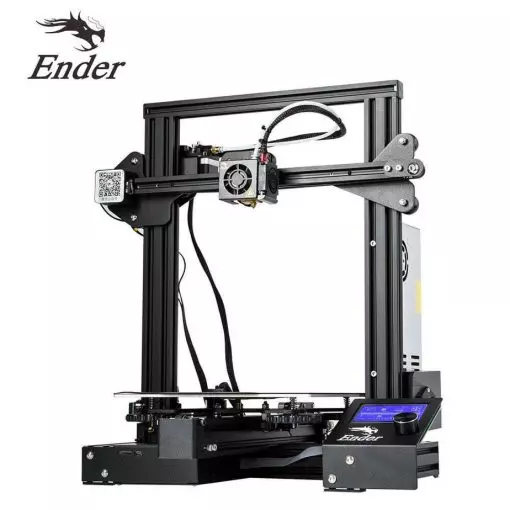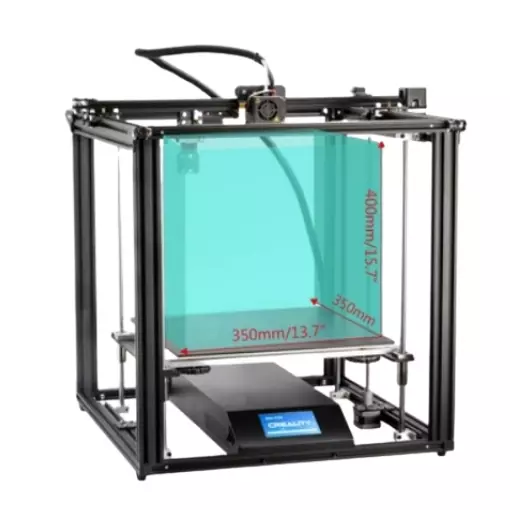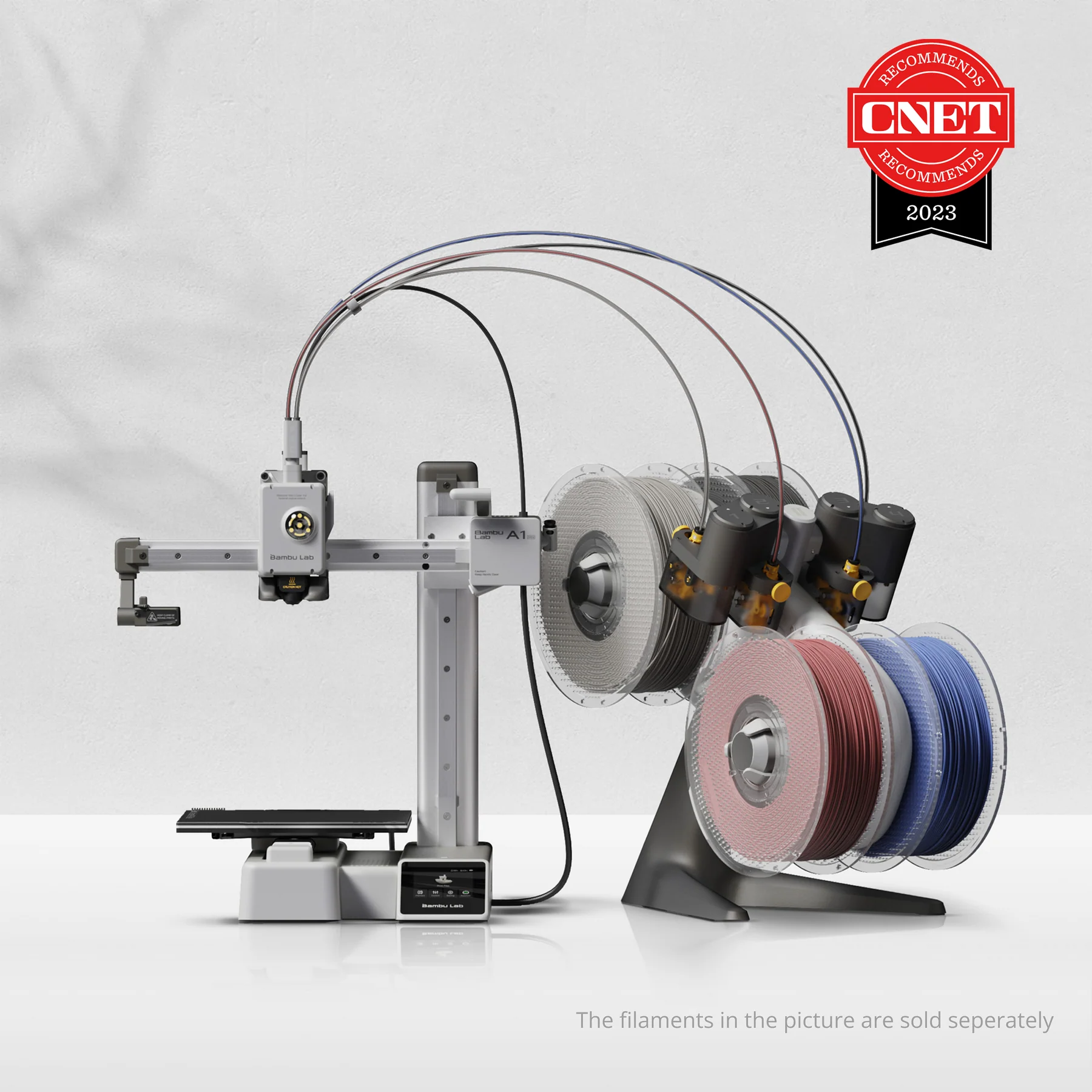Compare Ender 3 vs Ender 5 Plus vs A1 Mini
Comparison between the best 3D printers
Choose the best 3D printer at the best price. The cheapest 3D printers are here.
Buy a 3D printer here with 3D Fila.
 |
 |
 |
|
| Model | Ender 3[BUY Ender 3] |
Ender 5 Plus[BUY Ender 5 Plus] |
A1 Mini |
| Printing Material | Filament | Filament | Filament |
| Estimated price | $210,00 | $599,00 | $549,00 |
| Fabricante | Creality 3D | Creality 3D | Bambu Lab |
| Release Year | 2018 | 2019 | 2023 |
| Print Volume [mm] | 220x220x250 | 350x350x400 | 180x180x180 |
| Printer Size [mm] | 440x440x465 | 632x619x666 | 315x347x365 |
| Weight [kg] | 6,62 | 18,2 | 5,5 |
| Power Loss Recovery | NO | YES | YES |
| Enclosed printer | NO | NO | NO |
| Bed Leveling | Manual | Automatic | Automatic |
| Filament End Sensor | NO | YES | YES |
| Bed type | Heated | Heated | Heated |
| Power supply system | Bowden | Bowden | Direct Drive |
| Standard nozzle | 0,4 | 0,4 | 0,4 |
| Maximum Nozzle Temperature [°C] | 255 | 260 | 300 |
| Maximum Bed Temperature [°C] | 110 | 100 | 80 |
| Maximum printing speed [mm/s] | 180 | 180 | 500 |
| Filament holder | YES | YES | YES |
| Camera for supervision | NO | NO | YES |
| Recommended filaments | PLA, TPU, ABS, PETG | PLA, TPU, ABS, PETG | PLA, PETG, TPU, PVA |
| Recommended slicers | Cura, Simplify, Slic3r | Cura, Simplify, Slic3r | Bambu Studio, Super Slicer, Cura, Prusa Slicer, Orca |
| Maximum Resolution [mm] | 0,1 | 0,1 | 0,1 |
| Processor | 8 bits | 32 bits | 32-bit Silenciosa |
| Display | Mono | Touchscreen TFT 4,3'' | Touchscreen 2,4'' |
| Power Supply | 24V / 270W | 24V / 504W | 150 W |
| Connectivity | SD / USB | SD / USB | Wifi, Bambu bus, Cartão SD |
| Operating systems | Windows, Mac, Linux | Windows, Mac, Linux | Windows, Linux, Macbook |
| Date of registration in the system | 2021-04-13 | 2021-04-14 | 2024-04-10 |
| Release date | 2018 | 2019 | 2023 |
| Extra features | The Ender 3 V1 is a DIY assembly 3D printer, a sales leader since 2017, standing out for its cost-benefit. With a wide printing capacity, it has a CNC machined structure for precision and stability. It offers high-precision prints with low noise, thanks to its innovative V-profile and pulleys. It has a self-adhesive magnetic platform for easy removal of models and excellent adhesion. The Ender 3 heats up quickly, reaching 100°C in 5 minutes, ideal for agile prints. It includes protection against power failures, allowing you to resume printing after interruptions, saving time and material. | The Ender 5 Plus offers a large print volume (350x350x400 mm) and fast assembly. It includes a BLTouch sensor, but with range limitations. It stands out for its dimensional accuracy, although it requires adjustments to the slicer settings. Despite the noise, its integrated design saves space, and includes features such as a filament sensor and power resumption. Ideal for large projects, it requires refinement in the settings for high-quality prints. | The Bambu Lab A1 Mini stands out not only for its impressive speed and automatic calibration, but also for its multi-color printing capability thanks to AMS Lite. This innovative system makes multi-color printing easy, making it accessible to everyone. AMS Lite, specific to the A1 Mini, supports up to four different materials simultaneously, providing creative freedom without complications. With comprehensive sensors for energy monitoring and recovery, a camera for timelapses and Wi-Fi control, the A1 Mini and AMS Lite together offer an intuitive and advanced 3D printing experience, ideal for materials such as PLA, PETG and TPU, and designed for simplicity and fast maintenance with quick-change nozzles. |
| Support for multiple colors and materials (AMS and CFS) | NO | NO | YES |
Notes * |
|||
| Cost-benefit | 6 / 10 | 6 / 10 | 7 / 10 |
| Hardware | 0.5 / 10 | 2 / 10 | 4.8 / 10 |
| Screen | . | . | . |
| Print volume | 3 / 10 | 4 / 10 | 3 / 10 |
| Performance | 1 / 10 | 1 / 10 | 4 / 10 |
| [BUY Ender 3] | [BUY Ender 5 Plus] |
Conclusion |
| In the comparison of the Ender 3, Ender 5 Plus, and Bambu Lab A1 Mini 3D printers, several key factors emerge that can guide a buyer’s decision based on their specific needs and budget. The **Ender 3** stands out as the most cost-effective option, ideal for beginners and those looking for a reliable printer without breaking the bank. It offers solid print quality and a decent build volume, making it suitable for various projects, although it lacks advanced features like automatic bed leveling and print recovery. Its DIY assembly nature adds an educational aspect, but this might not suit everyone. On the other hand, the **Ender 5 Plus** caters to users requiring a larger print volume and greater dimensional accuracy. Despite being more expensive, its features such as automatic bed leveling and a filament sensor enhance the user experience significantly, particularly for larger projects. However, potential buyers need to be prepared for some adjustments in settings for optimal prints and occasional noise levels. The **Bambu Lab A1 Mini** is the newest entrant and boasts the most advanced features, including impressive printing speed, automatic calibration, and multi-color printing capabilities. Although it is priced higher than the Ender models, it offers significant value with its user-friendly experience and modern technology, making it a great choice for tech-savvy users and those interested in creative, multi-material printing. In conclusion, your choice of 3D printer should ultimately depend on your budget and specific needs. For the best cost-to-performance ratio, the **Ender 3** is a solid pick. If you need greater volume and more features for larger projects, consider the **Ender 5 Plus**. However, if you are looking for state-of-the-art technology with the most features, the **Bambu Lab A1 Mini** is an excellent investment. |

